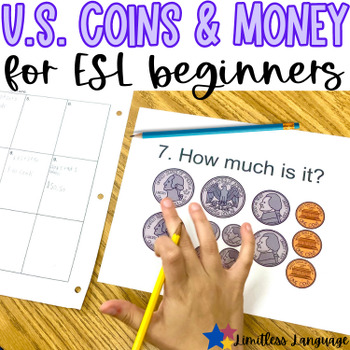US coins and money activities for ESL
- Google Drive™ folder

Also included in
- Do your ESL students need to learn, practice, and use STEM academic language? Do they struggle with using math and science terminology?All of the actvities, worksheets, puzzles and games in this bundle are designed to get ESL students of all levels actually using mathematical and scientific academicPrice $31.40Original Price $39.25Save $7.85
- A bundle of math-based language activities for your ESL beginner students! With these resources, your ELLs will learn to use math vocabulary in an authentic way. The resources included are as follows:Roll and Read Math language, Speaking and Writing ActivityMath Operations Notes and Speaking ActivitPrice $15.07Original Price $16.75Save $1.68
Description
Need some fun and practical activities to teach your ESL students the U.S. coins and money? Voila! This Google Drive folder includes a notes page to introduce the topic (with pictures of both sides of all the coins), a Gallery Walk activity, and a listening comprehension money practice game, and a money speaking Go Fish! game.
The instructions for the Gallery Walk and the Flyswatter game are in English and Spanish.
You could use these resources for a gen ed class, an ESL course, or for Special Ed support. They are fun and engaging. Read below for descriptions of each item included.
1. Notes worksheet w/ practice: use this to introduce the U.S. coins. There are sentence frames provided for students to write the name of each coin and the value. *I also make my students memorize the presidents that are on the coins, so you could add in this information as well.
2. Gallery Walk: print out the pages (ideally in color) and tape them up around your classroom. Also print the student answer recording sheet. Have students walk around the room counting the various amounts of bills and coins. An answer key is included for you.
3. Flyswatter Money & Coins Listening Game:In this game you will need either a flyswatter OR a long piece of paper rolled up to act as a swatter. You will say aloud an amount of money that is on the board. Students play in teams and compete to find and swat the amount you said. There are three different levels of difficulty. This is great listening practice for numbers as well as the coin amounts.
4. Teacher Answer Key for Gallery Walk
5. Go Fish Money Speaking Game: this Go Fish deck is US coins and money themed and comes with adorable pictures, clear text, and bright colors so that your ESL students are engaged and can play the game independently. Students will practice the words for US coins (penny, nickel, dime, quarter) and will see both the front and back of each coin on the card, thereby helping them learn to identify the coins. The game comes with a language reference sheet for students so that they have all the vocabulary and phrasing they need in order to play. This is a great way to build speaking fluency, vocabulary, and collaborative learning!
This resource aligns to the following state standards:
WIDA ELD Standard 1: Social and Instructional Language
WIDA ELD Standard 3: Language of Mathematics
Common Core ELA Speaking and Listening (tagged with TPT tool)
Common Core Math (tagged with TPT tool)






